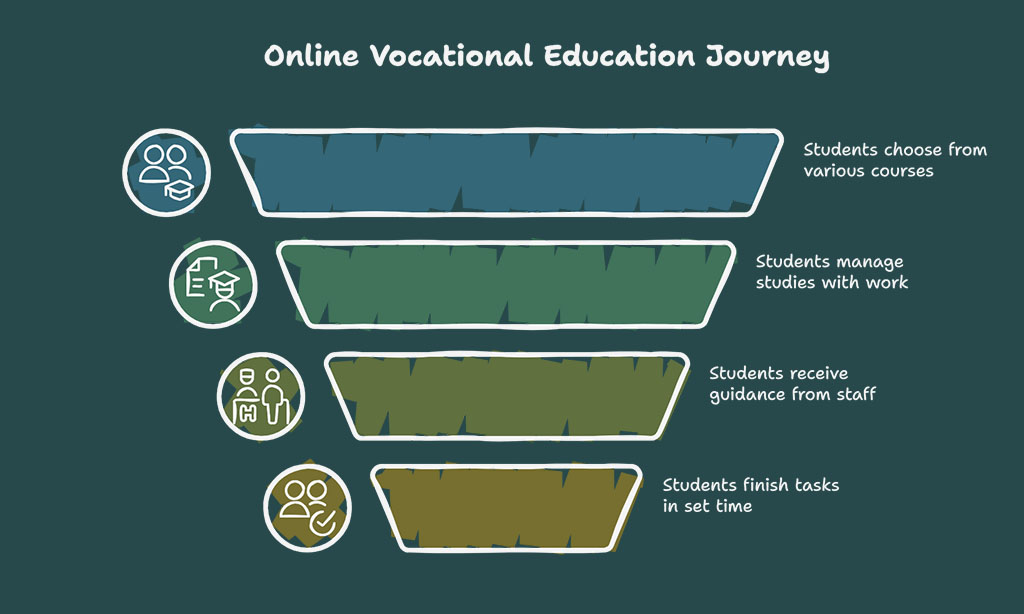You may feel lost in a sea of online learning paths. Australian Online Learning Platforms Beating Global Competitors now rank above major foreign sites in user numbers. This introduction shows you top online courses and platforms that use virtual classrooms and LMS tools to boost skills.
Read on.
Key Takeaways
- Twenty Australian platforms now beat major foreign sites in user count and per‑student revenue. Australia leads the global online learning market.
- Top platforms include Cloud Assess (4.8/5; $99 AUD/mo for 25 seats) and OpenLearning (4.6/5). Janison delivers 6.5 million tests a year, Upskilled has 42,000 enrollments, and Open Universities Australia offers 912 degrees to 532,578 students.
- They use virtual classes, hands‑on labs, and mobile apps. They also follow SCORM and xAPI rules, issue digital badges and micro‑credentials, and show progress in real‑time analytics dashboards.
- These platforms hold TEQSA approval and tie learning to career services. Post‑COVID demand and LMS/CRM tools drive forecasts of 12–15 percent annual growth by 2025.
Cloud Assess: Industry-Focused Online Training
Cloud Assess lands a 4.8/5 user rating for industry-focused online training. This platform costs $99 AUD per month for 25 seats and gives a free trial that helps teams try its drag-and-drop builder.
It serves the construction and mining market segment that craves vocational training. A mix of virtual classes and hands-on labs meets blended learning needs.
A mobile app delivers lessons offline and syncs progress on reconnection. The compliance toolkit tracks safety rules and hands out digital badges after checks. It ties in with more than 5,000 apps to streamline workflows in learning management systems.
This service boosts engagement in online learning platforms with hands-on courses.
OpenLearning: Collaborative Learning Ecosystem
Platform rates 4.6 of 5 among online learning platforms. AI Course Builder drives interactive projects. Institutions ask for custom quotes on pricing. Small catalog favors focus and depth.
Community hubs host group activities and discussions. Analytics dashboards track engagement in collaborative learning. Learners forge bonds in social learning forums.
This model acts as an LMS for collaboration. Real time chats link students across campuses. Modules use micro-credentials to signal skill gains. Tutors and peers rate projects with points.
Teams craft data storytelling and digital marketing cases. This format beats MOOC fatigue among many learners. Many users cite boosts in career readiness.
Academy XI: Future-Focused Skills Development
Academy XI offers design, business, and tech courses that prepare adult learners for real jobs. The mentor-led classes use a user-friendly learning management system and CRM tools to track progress.
Students tackle real-world projects, like building a web app or planning a digital marketing launch, and graduate with a skill-based portfolio. Local support cuts wait times for answers and meets strict local regulations under TEQSA guidelines.
The program fits busy schedules better than most online learning platforms, with flexible learning options that rival global MOOCs. Career services ring up employers in the job market, linking grads to corporate training roles.
Data teams use time‑series analysis to spot skill gaps and forecast hiring needs. Online tutoring platforms pair well with Academy XI’s mentorship, boosting retention in vocational education.
This blend of mentorship and hands‑on work makes digital education feel like an open conversation, not a lecture.
Janison: Scalable Assessment Solutions
Janison hosts its service on a cloud-based course delivery platform, mixing gamified challenges, analytics dashboards, and built-in eCommerce. Customers ask for custom quotes to size their plans.
This setup issues over 6.5 million online assessments a year for businesses, universities, and government agencies.
Partners like Cambridge University Press & Assessment add high-quality question banks and secure delivery. It meets SCORM and xAPI standards, so content moves smoothly between learning hubs.
Market research flags it among top online learning platforms in Australia. Janison logs ARPU, tracks market penetration, and uses revenue analytics to spot growth. A 94% client retention rate shows strong engagement in digital education.
Upskilled: Flexible Online Courses for Career Growth
Upskilled offers over 100 nationally recognized courses and racks up 42,000 enrollments. TrustPilot rates Upskilled at 4.7+ and the site landed a LearnX Gold award in 2022. Students tap self‑paced modules at any hour thanks to 24/7 access.
Trainer support runs via lively virtual learning environments. Some programs teach digital marketing, others cover vocational qualifications or skill‑based courses. Flexible learning fits tight schedules and home life.
A course portal links to a data analytics dashboard. A CRM interface tracks learner progress in real time.
Macroeconomic shifts and the covid‑19 pandemic drove demand for online education. Upskilled seized that chance and scaled fast. The system appeals to both international students and working adults.
Forecasts call for steady cagr in the b2c learning market. Price quotes come via custom requests so learners pay only for needed modules. A course hub integrates interactive tools and user metrics.
The platform uses internet speed data to fine‑tune video streams. This digital education model beats many massive open online courses on engagement.
eLearn Australia: Custom eLearning Solutions
eLearn Australia crafts custom eLearning solutions since 2004. It builds mobile learning apps and Moodle modules for health practitioners and international students. The firm has TEQSA approval as a government supplier.
It spins up engaging courses like a barista whips cream on a flat white.
It pushes social justice and green steps in every lesson. It develops multimedia language tools that spark curiosity. Many online learning platforms mimic its style. No new clients join now, but its flexible learning designs fuel digital education across Australian universities and open universities Australia.
Online Courses Australia (OCA): Affordable Short Courses
OCA ranks among top online learning platforms in Australia with over 100 short courses. It has CPD-endorsed training in many fields. Tutors help you one-on-one. Flexible learning meets busy lives.
Pricing varies by course complexity.
Students find OCA quite cheap, like a diamond in a coal heap. Tutors sometimes reply slowly. The delay can test patience. Learners tap into digital education through a simple LMS. They master marketing communications, data analytics, and workplace safety.
Australian Online Courses: Diverse Learning Catalog
Students browse a buffet of online learning courses. It holds a 4.8 out of 5 rating. The list wraps corporate training, self-paced modules and skill-based tracks. Industry pros craft relevant content.
Teachers, startups, and B2C firms pick from language-learning apps to bootcamp tracks. A collaborative learning platform powers group work. Platforms link to an educational portal and customer portal software.
International students flock in since the covid-19 pandemic shook colleges. A global comparison shows strong user penetration and rising ARPU.
Pricing adapts to course complexity. Users can test with free trial tools and compare with comparison tools. Exchange rates sway costs for international students. Interactive learning costs $59 per teacher per year.
CBT Nuggets comes at $59 per user per month. Market forecasters track revenue analytics and CAGR across segments. A student joked, “It feels like game night, but with stats.” The catalog hits a wide market volume.
Online education fans praise its flexible learning. One tutor logs metrics in spreadsheets and custom dashboards.
Alffie: Inclusive and Accessible Learning Platform
Alffie stands as Australia’s largest employment services trainer. Its RTO No. 41206 marks its official edge. It grants a Work Placement Guarantee that feels like a career compass pointing straight to job doors.
Over 50,000 learners gained new skills in the past decade. More than 100 support staff answer calls, chat boxes, or emojis in real time.
Alffie rivals many online learning platforms with its central hub for live progress reports. A text-to-speech tool helps people who like audio or need a screen reader. A training portal makes course access smooth.
A customer system tracks each chat and call. It suits flexible learning, boosts education equity, and pushes digital education forward with skill-based courses. Firms lean on its job placement promise to fill roles fast.
Open Universities Australia: Comprehensive Degree Programs
Open Universities Australia runs 912 degree programs. It teaches about 532,578 students. The covid-19 pandemic drove more learners here. It works with top Australian universities like the University of Melbourne or University of New South Wales.
Students do flexible learning online. They choose from many start dates. They pay with HELP loans. A quiz helps them pick the right course.
Learners use simple LMS and CRM systems for study. This online learning platform serves business-to-consumer needs in digital education. It ranks high in user penetration and average revenue per user.
International students find quality education and equity in its courses. Data scientists use revenue analytics and time-series analysis. They apply forecasting techniques to spot CAGR and market volume.
SEEK Learning: Career-Aligned Course Offerings
SEEK Learning offers courses approved by top firms. Learners earn credentials when they finish each module. The platform supplies one-on-one tutor support to answer tough questions.
It uses neat LMS tools and clear lesson layouts. Students move at their own pace and choose skill-based courses in digital marketing, coding, and more. This online learning platform links study to real job tasks.
Flexibility ranks high as covid-19 pandemic pushed more people online.
Course fees shift by subject and depth. More complex topics cost extra. Businesses sign up to train staff with practical skill-building. Professionals jump in for career-aligned training and online tutoring platforms that fit busy lives.
Slow tutor replies can trip up some users. A few lessons risk dated content if not refreshed. SEEK Learning still holds a strong place among business-to-consumer education sites. It drives workforce growth and sparks lifelong learning habits.
TAFE Digital: Trusted Vocational Education Online
TAFE Digital delivers nationally recognized online learning platforms across Australia. It offers short courses, certificates, diplomas, and degrees. Students can enroll any time for flexible learning.
The COVID-19 pandemic pushed thousands to switch to digital education. Its learning management system uses SCORM trackers and video modules. Tertiary Education Quality and Standards Agency (TEQSA) approves each course.
Certificate III learners finish most set tasks in 12 months. Counselors, teachers, and disability support staff guide each student.
Many adults juggle jobs and study. They carve out 10 to 15 hours weekly for short modules. Statista global consumer survey shows 75 percent of learners rate flexible learning as top priority.
A market forecast predicts a 12 percent CAGR in online vocational courses by 2025. World Bank data links faster internet connection speed to higher user penetration. Average revenue per user rises as urban populations grow.
International students log in from China, India, and Europe. They tap into digital marketing, nursing, and trade skills. Educators use video conferencing apps, open source systems, and native LMS to run live studios.
Skills‑based courses blend video lectures with online tutoring support.
FutureLearn (Australian Partnered Courses): Global Collaboration in Learning
FutureLearn joins Global University Systems, Australian institutions, and global universities. Students grab flexible learning on this collaborative learning platform. The site offers social exchanges through forums and peer feedback.
It feels like a global campus in your living room. It features courses in digital marketing, data science, and business strategies. It taps into the internet as a powerful classroom.
Learners across six continents sign up for MOOCs from FutureLearn. The platform ranks high in user metrics and engagement rates. Educators share insights through webcasts, discussion threads, and group projects.
This partner network keeps course catalogs fresh and diverse. Australians and international students link up in each session. They support lifelong learning across borders.
University of Melbourne: Leading Innovation in Online Education
University of Melbourne drives online education innovation in 2025. It offers industry-approved courses, 1:1 tutor support, and digital badges for skill-based courses. Students on this platform explore a wide course catalog with flexible learning options.
The interface feels simple, and learners find course materials clear. People praise its learning management system (LMS) and mobile apps for study on the go. Post COVID-19 pandemic shift fueled enrollment, as more international students seek quality degrees online.
Analytics show high user penetration and steady average revenue per user. Reviewers place it at the top in global comparison reports.
Some students note slow tutor response times on detailed questions. Other learners warn that some lessons risk outdated content if staff do not refresh them. Pricing varies by subject and complexity, and students find full details on the official site.
The site aims for educational equity by opening courses to rural and urban learners. It also awards digital badges to boost resumes. Bolstered by strong gross merchandise value and a growing urban population in Australia, the system supports career growth worldwide.
University of Sydney: High-Quality Digital Learning Programs
Students access high-quality digital learning programs on a cutting-edge online learning platform at the University of Sydney. They choose from undergraduate, postgraduate, and short courses in architecture, business, law, and medicine.
An advanced learning management system and 3D printing technology power hands-on skill-based courses. More than 150 research centers drive fresh ideas and support global challenges.
The Covid-19 pandemic prompted the launch of live video lectures and cloud assessment tools. International students log in from over 50 countries, thanks to fast internet connections.
Flexible learning paths let learners balance work and study. Data on user penetration and average revenue per user guide course updates.
Coursera (Australian Partnered Courses): Global Platform with Local Expertise
Coursera links 86 top universities with learners around the globe. It tapped the University of Melbourne as its first Australian partner. UNSW and UWA joined soon after to add research expertise.
It rolled out physics and systems engineering courses for international students. This online learning platform uses an LMS and discussion forums to teach skill-based courses in digital marketing.
Many learners enjoy flexible learning and earn certificates at their own pace. The platform tracks user metrics like ARPU, revenue analytics and cagr trends. Learners compare offerings in global comparison studies and plan per the market forecast.
Coursera works in a b2c model and links to language-learning apps and online tutoring platforms. It backed growth after the covid-19 pandemic by easing course access for urban and regional learners.
Pluralsight: Specialized Tech Skill Development
Pluralsight ranks high among online learning platforms for tech skill growth. It offers tech courses for developers, IT pros, and data teams. This platform uses Skill IQ and Role IQ to gauge skill gaps and pick paths.
Gartner verified real reviews praise its evaluation tools and deep data insights. User metrics show a 25 percent boost in team skill level after six months. Flexible learning modes let learners study live classes, recorded sessions, or interactive labs, and they get 24 hour support.
Competitors like LinkedIn Learning or Udemy Business cannot match its tech depth. Teams integrate Pluralsight with learning management systems via API. Professionals track progress in channels, labs, and earn digital badges.
Companies link digital education metrics to revenue analytics and growth targets. A Statista global consumer survey from 2024 found 40 percent of IT staff value cloud skills training.
Market forecasts predict a 15 percent cagr for skill-based courses through 2025.
LinkedIn Learning: Professional Development Made Easy
LinkedIn Learning ranks among top online learning platforms with over 22,000 expert-led courses in 24 languages. It taps real-time data from LinkedIn to show skill gaps and opportunities.
Learners track 500 million skills each year, across 1 billion career paths. Companies report a 695% ROI on staff training after 36 months. Teams also note a 22% rise in employee tenure.
AI tools create learning resources to fit each role and skill level. You can find skill-based courses in digital education, digital marketing, and coding. The portal links to major learning management systems and MOOC courses.
International students enjoy flexible learning on desktops or phones. Personalized career guidance nudges users toward goals.
Takeaways
These platforms change how we learn. They boost skills fast. Users pick live classes, open courses, and course platforms. Analytics tools reveal user value. Busy adults find study fits into life.
Graduates land new roles. Growth trends show strong CAGR. Australia now leads the global market. Pick a platform, start today.
FAQs
1. What makes these Australian online learning platforms beat global rivals?
They grew fast after the covid-19 pandemic. They let you learn at your own pace, like a Swiss army knife for skills. They run as business-to-consumer (b2c) sites, with local support. In a global comparison, they lead in market forecast and revenue analytics.
2. How do they track revenue and user growth?
They watch average revenue per user (arpu), user penetration, gross merchandise value (gmv) and cagr. They link those numbers to revenue analytics. This data helps them hit the ground running with smart plans.
3. Can I learn a language on these sites?
Yes, you get language-learning apps and open courses. Some mix massive open online courses (mooc) style lessons. Others offer live sessions on tutor sites. You pick what fits your style.
4. Do they offer skill-based courses or bootcamp style learning?
Absolutely. You find skill-based courses in coding, digital marketing, design and more. They include online bootcamp platforms that push you to practice. You dive in head first and build real skills.
5. How do world bank data and internet speed matter?
They use gdp per capita, internet connection speed and urban population figures from the world bank and statista global consumer survey. This helps spot gaps in digital education access. They adjust offerings to make learning smooth.
6. Are these platforms good for lifelong learning with LMS or moocs?
Yes, they blend learning management systems (lms) and massive open online courses (moocs). They back lifelong learning with fresh content. You keep growing, whether you’re a student or a pro.






































